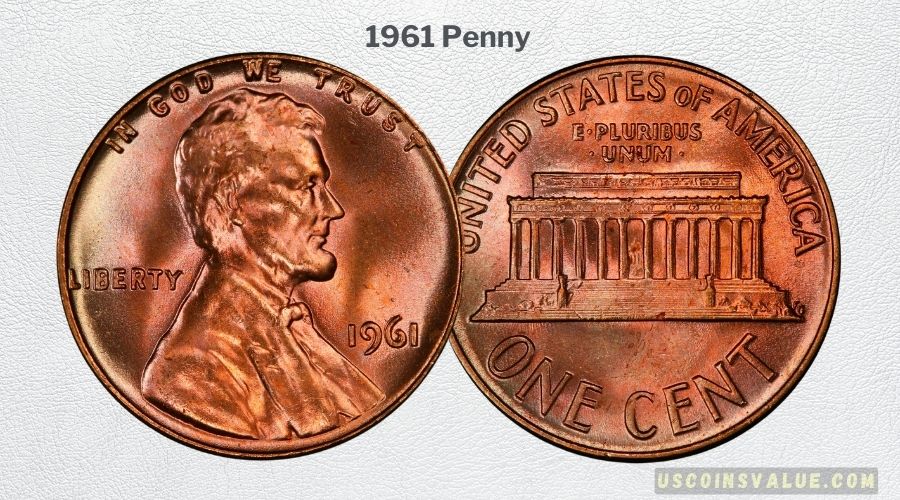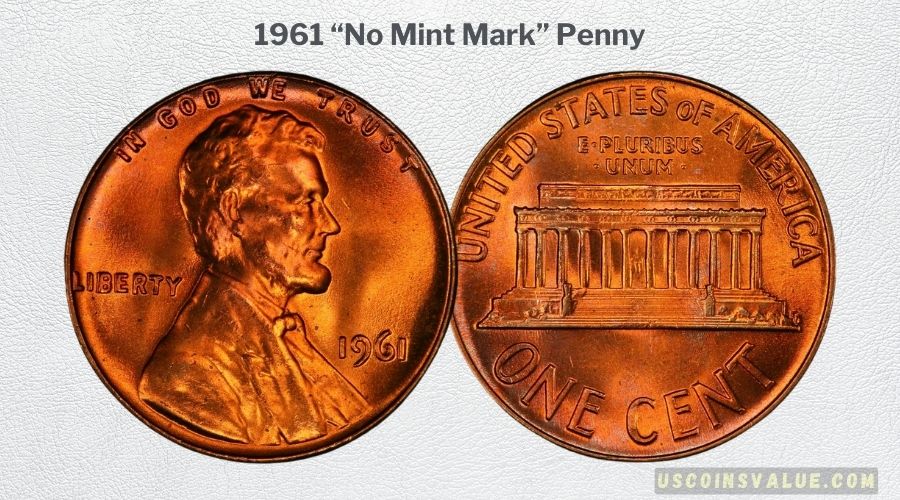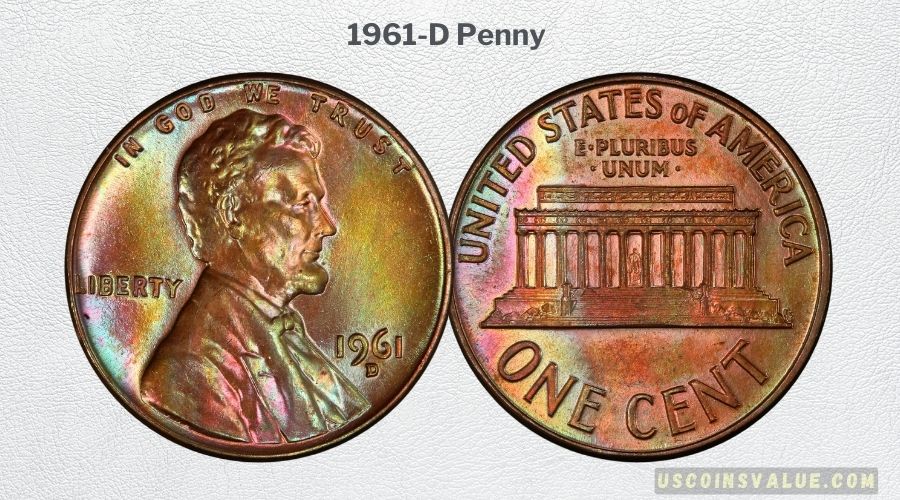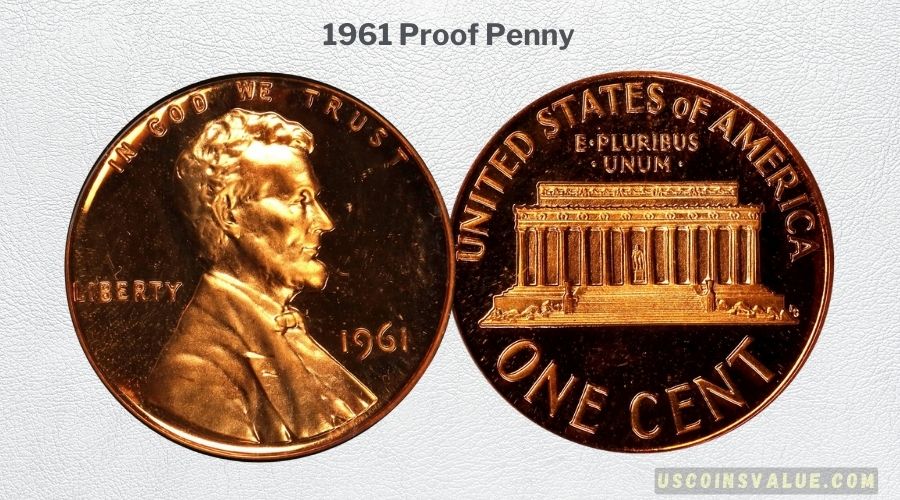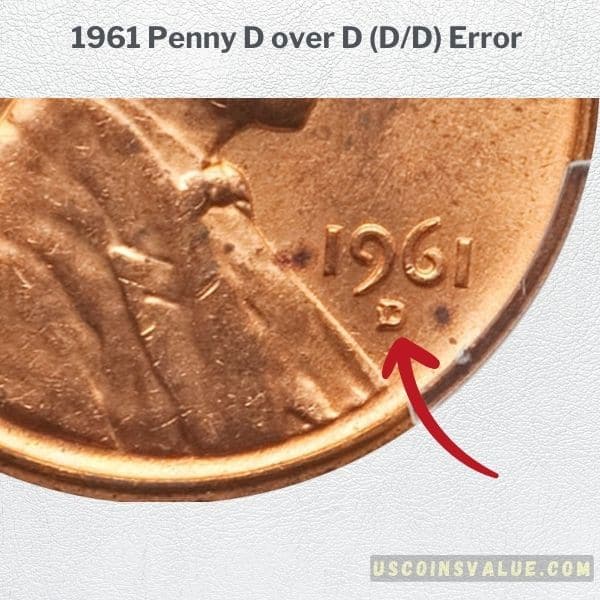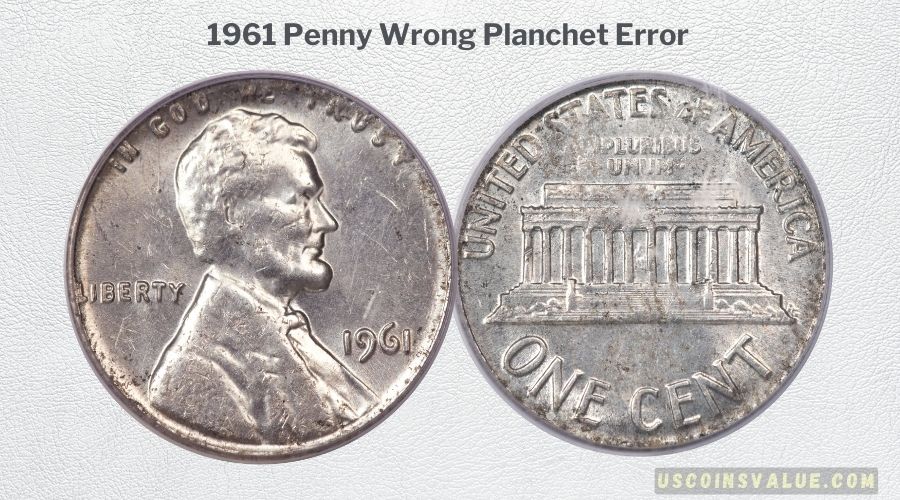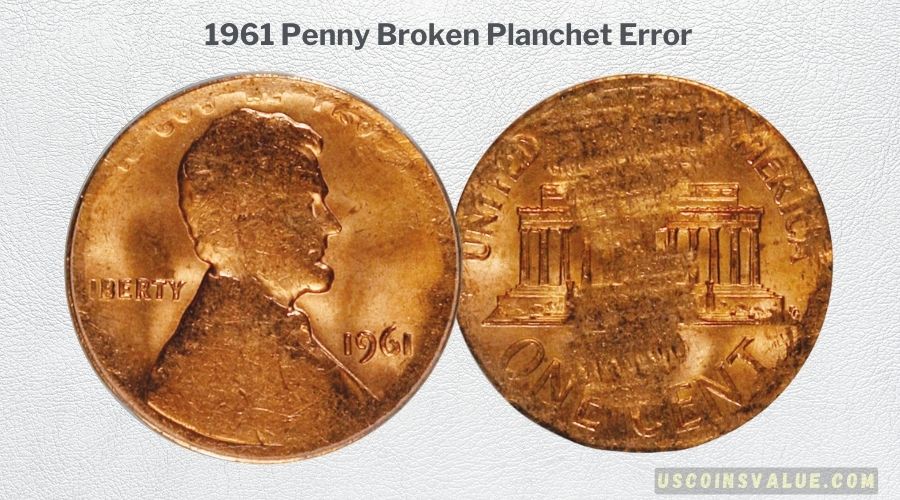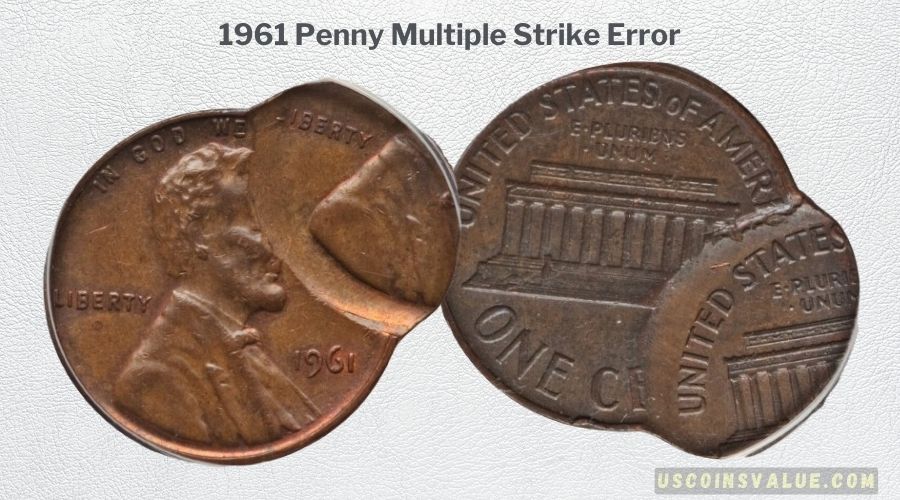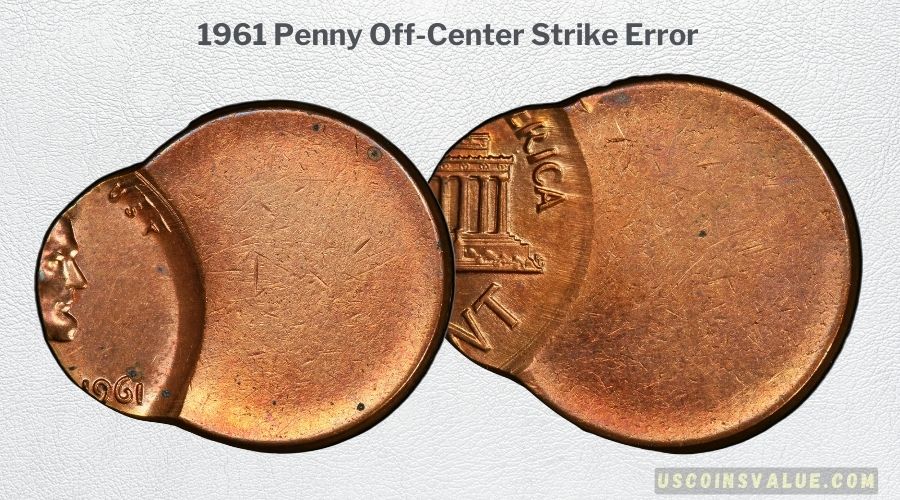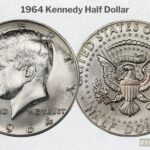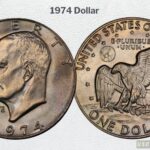Do you think the 1961 penny has outlived its value? You’re wrong! This year’s $6,600 auction record shows these pennies still command a high value.
A regular strike 1961 penny costs $0.17 – $1.16 in Mint State and at least $1.75 – $5 in PF60 for Proof variants. These three factors affect the value.
- Grade: PF68 – PF69 and MS67 are the highest valued grades.
- Variety: 1961 Proof pennies are the most valuable.
- Errors: 1961 pennies with unique errors have higher prices because of increased demand for limited supply.
Follow this guide to help you collect a valuable 1961 penny.
What is the Background of the 1961 Penny?
The 1961 penny is part of the modern Lincoln Memorial series, launched in 1959. It fused the existing Lincoln head design by engraver Victor David Brenner with a new reverse by Frank Gasparro.
Between 1955 and 1964, the San Francisco Mint only worked as an assay office, so there’s no 1961 penny with an “S” mint mark. Instead, the Philadelphia Mint produced all-proof coins for that year.
As the third year of production, it’s one of the first sets in the series and holds sentimental sway amongst collectors.
The 1961 Penny Features: What Does it Look Like?
- Series: Lincoln Memorial (Modern)
- Year of Make: 1961
- Mintage: 3,028,244 (Proof) | 1,753,266,700 (D) | 753,345,000 (P)
- Mint Branch: Philadelphia, Denver
- Composition: 95% Copper and 5% Zinc and Tin
- Weight: 3.11 g
- Diameter: 19 mm
- Edge: Plain
Obverse & Reverse Design: What Does the Keyword Look Like?
The 1961 penny has the same face as every one-cent coin you’ll see in America today. That’s because it’s part of the modern Lincoln Memorial series. The Obverse features a side profile of Lincoln’s upper body facing right.
He’s wearing a suit and bowtie with his curly hair cropped short and a full beard. Other details on the field (background) include:
- LIBERTY
- IN GOD WE TRUST
- 1961
- Mint Mark: D for Denver
On the Reverse side, there’s a bold engraving of the Lincoln Memorial building at the center instead of his portrait. The details on the field are also different. They include:
- UNITED STATES oF AMERICA
- PLURIBUS.UNUM.
- ONE CENT
- “FG”
What are the 1961 Penny Varieties?
You’ll find three varieties of the 1961 penny, from the “no mint mark” pieces made in Philadelphia to the Denver-minted and Proof coins. They all have the same Copper-plated Zinc composition with different mintages.
| 1961 (Lincoln Memorial) Varieties | Composition | Mint Location | Mintage |
| 1961 “no mint mark” Penny |
95% Copper & 5% Tin and Zinc
|
Philadelphia | 753,345,000 |
| 1961-D Penny | Denver | 1,753,266,700 | |
| 1961 Proof Penny | Philadelphia | 3,028,244 |
1. 1961 “No Mint Mark” Penny
The 1961 “no mint mark” penny came from Philadelphia and earned its name because the Philly Mint doesn’t mark its coins. They’re made from copper-plated zinc and come in three colors — Brown (BN), Red-Brown (RB), and Red (RD).
There were 753,345,000 pieces minted, making the “no mint mark” 1961 penny the second-highest mintage. It’s the least valuable variant.
2. 1961-D Penny
The Denver-minted 1961-D pennies also come in three standard Regular Strike colors — red, red-brown, and brown. It’s also made of 95% Copper & 5% Tin and Zinc and has the highest mintage of the year at 1,753,266,700.
This variant is the most valuable regular strike 1961 Lincoln cent.
3. 1961 Proof Penny
1961 Proof pennies come in three colors: Red (RD), Cameo (CAM), and Deep Cameo (DCAM). Proof coins are made using the first die and planchet to test a new set. The process creates a cameo finish that gives the currency a glossier and mirror-like surface.
When the coin has a black field and copper details, it’s categorized as Deep Cameo. Coins with the standard earthy red color but frosty surface retain their RD tag. The Proof 1961 penny is the most valuable variant.
What’s the Current Value of the 1961 Penny?
The 1961 penny is still very valuable this year, although it depends on the grade. The “no mint mark” and 1961-D variants are only worth money from MS63+ until MS67. Meanwhile, the Proof 1961 pennies are valuable from PR60 – PR70.
| MS/PR | 1961 “No Mint Mark” Penny | 1961-D Penny | 1961 Proof Penny |
| 60 | – | – | $5 – $8 |
| 61 | – | – | $6 – $9 |
| 62 | – | – | $7 – $12 |
| 63 | $8 – $10 | $6 | $8 – $18 |
| 64 | $14 – $16 | $8 – $9 | $10 – $28 |
| 65 | $22 – $24 | $15 – $20 | $15 – $42 |
| 66 | $32 – $100 | $26 – $185 | $20 – $62 |
| 67 | $750 – $8,250 | $700 – $10,000 | $25 – $160 |
| 68 | – | – | $40 – $900 |
| 69 | – | – | $150 – $5,500 |
1. 1961 “No Mint Mark” Penny
2023 is a good year to trade your 1961 “no mint mark” penny, as records show high prices.
Heritage Auctions sold an MS67 grade for $720 in April and $450 in January 2023. Meanwhile, buyers on eBay spent way less in August of the same year for an MS65 grade of $3.
2023’s eBay sales include $14 – $23 for MS66 grades. The auction record for the 1961 “no mint mark” penny stands at $5,720 by Great Collections for an MS67 piece. Here are the top five highest sales ever.
| Grade | Highest Price & Sale Date | Firm |
| MS67 | $5,720 (2013) | Great Collections |
| MS67 | $3,520 (2013) | Great Collections |
| MS67 | $3,173 (2013) | Stack’s Bowers |
| MS67 | $1,080 (2017) | Heritage Auctions |
| MS67 | $999 (2017) | Heritage Auctions |
2. 1961-D Penny
Sales of the 1961-D penny in 2023 have been average. An MS67 piece at David Lawrence RC sold for $40 in January, while Heritage Auctions sold an MS67 grade for $198 in April, 2023.
As a buyer, you can get an MS63 – MS65 1961-D penny at a cheaper rate from eBay. In May, an MS65 grade went for $10.
In July 2023, the exact grade sold at $5, and in August of the same year, an MS66 grade sold for $12. But the auction record from 2014 stands at $4,406.25.
See the highest prices ever here.
| Grade | Highest Price & Sale Date | Firm |
| MS67 | $4,406.25 (2014) | Heritage Auctions |
| MS67 | $4,242 (2013) | Stack’s Bowers |
| MS67 | $4,113 (2014) | Heritage Auctions |
| PCGS Genuine | $4,000 (2021) | eBay |
| MS67 | $3,819 (2014) | Heritage Auctions |
3. 1961 Proof Penny
The highest sale for any 1961 penny is a Proof coin sold this year by Stack’s Bowers for a whopping $6,600. So, it’s safe to say the 1961 Proof penny is the most valuable variant currently.
Other sales this year include $176 for PR66RD by David Lawrence RC, $107 for PR66RB by Heritage Auctions, and $6 – $81 on eBay. As you’ll see in this table, the highest prices for 1961 Proof pennies span two decades.
| Grade | Highest Price & Sale Date | Firm |
| PR69 DCAM | $6,600 (2023) | Stack’s Bowers |
| PR69 DCAM | $4,320 (2018) | Heritage Auctions |
| PR69 | $4,025 (2008) | Heritage Auctions |
| PR69 | $3,450 (2005) | Heritage Auctions |
| PR69 | $3,335 (2003) | Heritage Auctions |
Common Errors You’ll Find in a 1961 Penny
The 1961 pennies weren’t always perfect. Sometimes, errors could happen pre-, during, or after production. When they did, the Mint recalled the flawed coins, but some had already entered circulation and became modern-day collectibles.
We’ve chosen five popular errors that have made money this century.
- D over D Error (D/D)
- Wrong Planchet Error
- Broken Planchet Error
- Multiple Strike Error
- Off-Center Strike Error
1. D over D (D/D) Error
D/D error is exclusive to the Denver-minted coins because of the “D” mint mark. It’s a mint-made error that happens during production. This error is similar to the repunched date RPD oddity that allows details to appear twice.
Instead of an RPD, you’d get a duplicated mint mark from a double strike. D/D 1961 pennies sold for $216 and $219.60 in 2022 at Heritage Auctions.
2. Wrong Planchet Error
If your 1961 penny has a different size than 19mm and 3.11g or a color that’s not copper-plated zinc, it results from a wrong planchet. To be a valuable wrong planchet error 1961 penny, the coin’s planchet must belong to another valid denomination.
A 1961 Lincoln cent struck on a silver dime planchet sold for $1,265 in 2011. Earlier in 2006, a similar MS62 grade 1961 Lincoln cent struck on a silver dime planchet sold for $1,035.
3. Broken Planchet Error
Another standard planchet error is when it’s broken. So, a planchet is the blank metal used to create the coin. If cut wrongly, the coin’s details would come out skewered. As such, you’d have partial details on the field and sometimes missing edges on the circumference.
This year, a 1961 penny with a curved clip on a split planchet before strike sold for $81. In 2013, it sold for $65 and an MS64 grade went for $92 in 2007 all at Heritage Auctions.
4. Multiple Strike Error
A 1961 penny with a multiple strike error results from a shifted planchet, slack retaining collar, or faint die during mintage. So, there was a need to hit the planchet a second time for clearer details on the coin’s field.
As expected, a multiple-strike error caused duplicate images on the 1961 penny and sometimes shifted details from the standard frame.
- In 2022, a double struck 1961 Lincoln cent with 75% off-center strike sold for $234.
5. Off-Center Strike Error
You’d get an off-center strike when the planchet shifts from its position because the retaining collar is loose. The strike could hit close to the standard point, like 2% – 5%, or significantly out of focus at 60% – 90%.
Wider off-center strikes leave empty fields with barely visible partial details. Last year, a 1961 cent with 85% off-center strike sold for $129 and in 2022, a 50% struck off-center MS63 grade sold for $69.
So, the wider the off-center strike, the more valuable the 1961 penny becomes.
Final Thoughts
Reviewing the history, varieties, and values of the 1961 penny has been interesting. Here’s a recap of what’s been said so far:
- There are three varieties of the 1961 penny ( “no mint mark,” “D” mint mark, and Proof coins.)
- All variants come in three different colors.
- The value depends on the grade of the 1961 penny.
Hire a professional to grade your 1961 penny before selling, and ensure you only pay premium prices for certified pieces. Getting a 1961 Proof DCAM coin is the best choice if you’re investing, while the 1961-D is suitable for hobby purchases.

